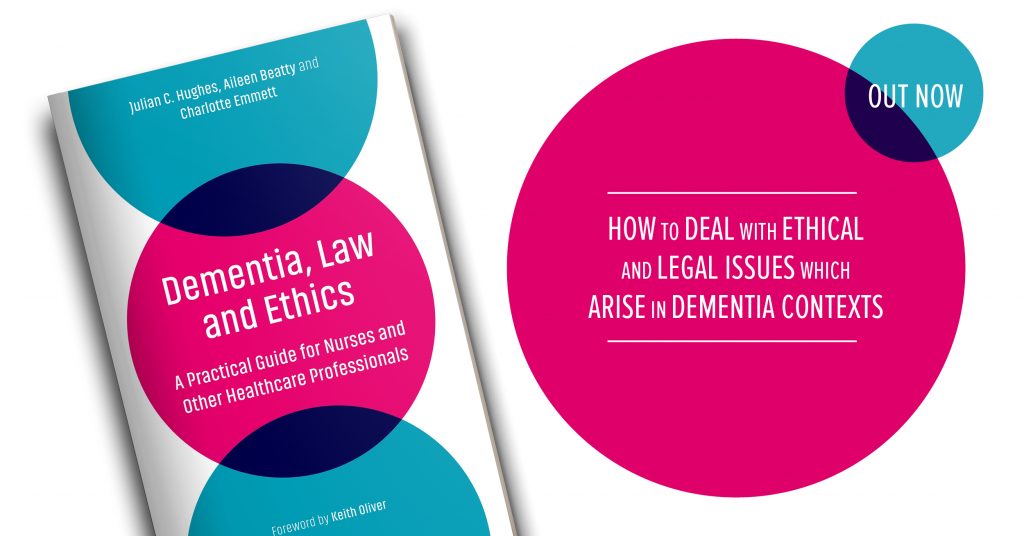Written by Julian C. Hughes, Aileen Beatty and Charlotte Emmett

When a book is written by three people, there are two very natural questions. First, how did three people write a book together? And, secondly, how did this happen in the first place? That is, are they friends or colleagues, or did the publisher bring them together purely for the purpose of writing the book?
It’s quite easy to answer the first question in connection with our book Dementia, Law and Ethics: A Practical Guide for Nurses and Other Healthcare Professionals. We all looked at all of it on multiple occasions and made suggestions and, from time to time, edits to parts that the others had written. In the bulk of the book (Part II, which is about different ethical issues), Aileen wrote the case vignettes, Julian then provided an ethical commentary and Charlotte added the legal commentary. We had to interact to make sure that what we said remained true and convincing clinically, ethically and legally throughout the book.
The second question is more interesting, perhaps, in the way that human interest stories are always more interesting than reading about theory. But we want to use the human interest story to make a more profound point. It is the point that motivates our book. It is the fundamental point, we hope, to be taken away from reading our book. (We hope it’s not, of course, the only point!)
Aileen and Julian started working together when Aileen was brought in as a senior nurse to the Psychiatry of Old Age Service in North Tyneside to establish and manage services for people living with advanced dementia who also had behaviours that were challenging. Aileen established the behaviour support service, as it was called, which was both a specialized in-patient unit and a community team working into care homes. Julian provided consultant medical input to the teams. There were two things of importance about the behaviour support service. First, it was genuinely interdisciplinary. Medical input was required, but the psychosocial skills of the nurses were central. The input we received from the very dedicated pharmacist (whose mission was always to “deprescribe” if at all possible), as well as from the psychologist and occupational therapist, was also crucial. Second, frequently the challenges we faced were ethical as well as being biopsychosocial. Aileen and Julian wrote a few papers and book chapters about some of the issues we faced.
Charlotte and Julian had known each other as research colleagues for some years and had worked on projects to do with the assessment of capacity in people living with dementia and advance decision-making. Discussions about mental health and mental capacity legislation eventually led to Charlotte visiting the behaviour support service in-patient unit at North Tyneside. And the service more broadly was keen to have her advice around issues such as deprivation of liberty. It was useful for Charlotte to see the pressing nature of the issues first-hand. Meanwhile, Charlotte and Julian were also busy writing about capacity (or competence) and other topics, such as best interests, in a variety of papers and chapters.
Again, the inevitability of interdisciplinary work was obvious and legal issues were often to the fore.
It started to seem clear that the three of us should also work together at some point. For dementia care seems naturally to involve not just medical and nursing input, not just the professionals from other disciplines too, but also ethical and legal considerations. This is the profound and fundamental point that motivates our book. Let’s make the point again by considering one of the examples we use in the book.
In Chapter 13 we discuss Katie, who has advanced dementia and has been admitted to a care home. There she exhibits behaviour that is challenging. She is hitting staff, but is also at a high risk of falling. A question arises as to whether or not she should be given medication to calm her behaviour. When we discuss this ethically, we point to the interpretation and meaning of the behaviour and how we might thereby understand it in Katie’s case. In passing we mention the principles of doing good and avoiding harm. In terms of the law, we discuss the legislation relevant to the use of restraint, which covers all the varieties of restraint (from physical to pharmacological) and the importance of that restraint being proportional and the least-restrictive possible.
The point we make throughout the book is that clinical decisions are at one and the same time ethical and legal. Actually, this point is so obvious (once you think of it) that it almost seems self-evident. Should we use this medication? Should people living with moderate dementia be allowed to go for walks on their own? Should they drive? Should antibiotics and feeding-tubes be used at the end of life? And so on! In every case, both formal (professional) and informal (family) carers are faced by sometimes difficult decisions which are also ethical (i.e. is it right or wrong, good or bad?) and of great significance, as well as legal (e.g. on what basis may I infringe this person’s liberty in this or that particular way?).
Indeed, all this becomes so obvious it’s inconceivable that professionals working in this field would not have a basic grounding in ethics and law in order to do their work properly, confidently and with some pride. And during the Covid pandemic, the need for sound ethical and legal thinking has certainly not diminished!
Written by Julian C. Hughes, Aileen Beatty and Charlotte Emmett
You can learn more and get your copy of Dementia, Law and Ethics, here.